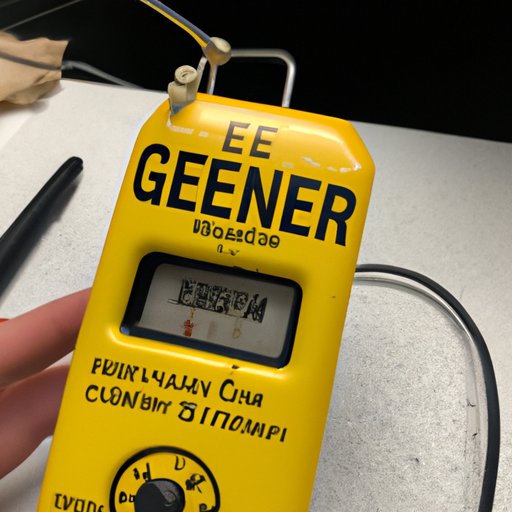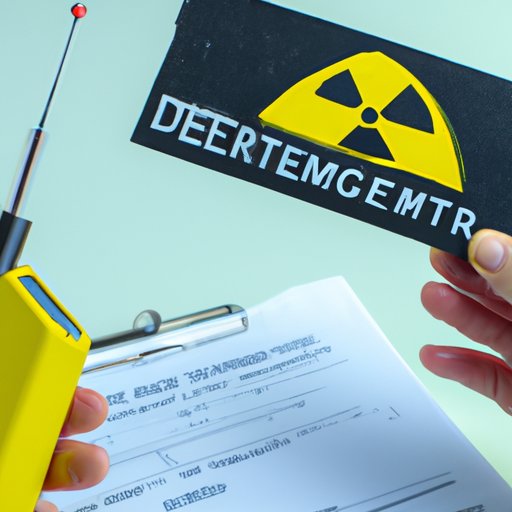Introduction
A Geiger Counter is a device used to measure levels of ionizing radiation. It is an essential tool for detecting and monitoring radiation in the environment, as well as in medical, industrial, and research settings. The purpose of a Geiger Counter is to detect and measure ionizing radiation, which includes alpha particles, beta particles, gamma rays, and x-rays.
The science behind a Geiger Counter is complex, but understanding how it works is essential for anyone working with radiation. This article will explore the physics behind a Geiger Counter, the components of a Geiger Counter, and how to use a Geiger Counter for radiation detection.

Exploring the Science Behind a Geiger Counter
At the heart of a Geiger Counter is the Geiger–Müller tube, which is the main component responsible for detecting radiation. The Geiger–Müller tube consists of two electrodes, one positive and one negative, separated by a thin layer of gas. When ionizing radiation passes through the tube, it ionizes the gas, creating an electric current between the electrodes. This current is then amplified and sent to the detector, which records the amount of radiation detected.
In order to accurately detect radiation, a Geiger Counter must be properly calibrated and maintained. Calibration is the process of ensuring that the Geiger Counter is sensitive enough to detect low levels of radiation, and that it is not over-sensitive to higher levels of radiation. Proper maintenance is also important to ensure that the Geiger Counter is functioning properly and that there are no leaks or other issues that could affect the accuracy of the readings.
Analyzing the Components of a Geiger Counter and Their Role in Radiation Detection
The key components of a Geiger Counter and their role in radiation detection are:
- The Geiger–Müller tube – This is the main component responsible for detecting radiation. It consists of two electrodes, one positive and one negative, separated by a thin layer of gas. When ionizing radiation passes through the tube, it ionizes the gas, creating an electric current between the electrodes.
- The amplifier – This amplifies the electric current created by the Geiger–Müller tube and sends it to the detector.
- The detector – This records the amount of radiation detected.
- The display – This displays the results of the radiation measurement.

How to Use a Geiger Counter for Radiation Detection
Using a Geiger Counter for radiation detection is relatively straightforward, but it is important to understand the basics before attempting to use one. Here is a step-by-step guide to understanding the functionality of a Geiger Counter:
- Calibrate the Geiger Counter – Before using a Geiger Counter, it must be properly calibrated to ensure that it is sensitive enough to detect low levels of radiation, and that it is not over-sensitive to higher levels of radiation.
- Set the Detectable Radiation Level – The level of radiation that the Geiger Counter can detect must be set according to the type of radiation being measured.
- Position the Geiger Counter – The Geiger Counter must be positioned so that it is directly facing the source of radiation.
- Take Measurement – Once the Geiger Counter is properly positioned, it can be used to take measurements of the radiation level in the area.
- Record Results – The results of the radiation measurement should be recorded in a logbook or other record keeping system.
Conclusion
The science behind a Geiger Counter is complex, but understanding how it works is essential for anyone working with radiation. This article has explored the physics behind a Geiger Counter, the components of a Geiger Counter, and how to use a Geiger Counter for radiation detection.
In conclusion, a Geiger Counter is an essential tool for detecting and monitoring radiation in the environment, as well as in medical, industrial, and research settings. It is important to understand the physics behind Geiger Counters, the components of a Geiger Counter, and how to use it for radiation detection in order to use it effectively.
(Note: Is this article not meeting your expectations? Do you have knowledge or insights to share? Unlock new opportunities and expand your reach by joining our authors team. Click Registration to join us and share your expertise with our readers.)
